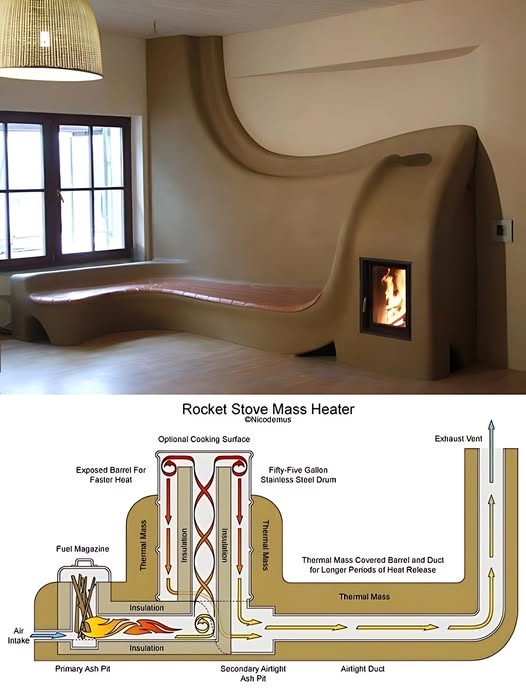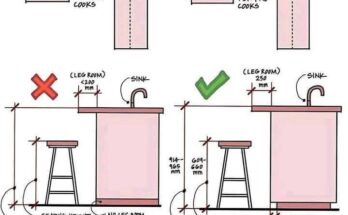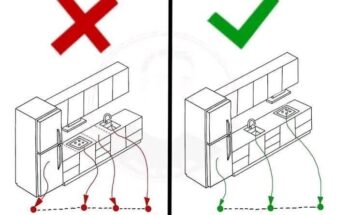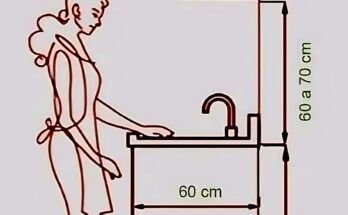This image displays a rocket stove mass heater, showcasing both its finished appearance in a living space and a schematic diagram illustrating its internal workings.
Top Section: Finished Rocket Stove Mass Heater
- Appearance: The image shows a large, sculpted structure built into a corner of a room. It has a natural, earthy tone and a smooth, flowing design.
- Integrated Bench: A curved bench extends from the main body of the heater, providing a warm place to sit. The seating surface appears to be made of a reddish-brown material, possibly brick or tile, to retain heat.
- Firebox: A small opening with a door is visible on the side of the structure, revealing a fire burning inside. This is the firebox where the fuel is combusted.
- Chimney/Exhaust: A curved chimney rises from the top of the heater and disappears out of view, carrying exhaust gases away.
- Thermal Mass: The large, bulky form of the heater indicates a significant amount of thermal mass, designed to absorb and slowly release heat.
- Setting: The heater is situated in a room with a window, light-colored walls, and a pendant lamp, suggesting a residential environment.

Bottom Section: Schematic Diagram of a Rocket Stove Mass Heater
The diagram provides a cross-sectional view of the internal components and airflow:
- Fuel Magazine: This is where the fuel (typically wood) is loaded vertically. Air intake is located near the bottom.
- Primary Combustion Chamber: The area where the fuel burns intensely due to the efficient air intake. A primary ash pit is located below.
- Insulated Riser: A vertical, insulated chamber above the primary combustion. The insulation is crucial for maintaining high temperatures and promoting complete combustion.
- Heat Exchanger: A series of channels or a barrel (often a “Fifty-Five Gallon Stainless Steel Drum”) where the hot exhaust gases travel. This is where the thermal mass absorbs the heat. The diagram shows options for an exposed barrel for faster heat release or a thermal mass-covered barrel and duct for longer periods of heat release.
- Thermal Mass: The material surrounding the heat exchanger and potentially the riser. This absorbs and stores the heat from the exhaust gases.
- Optional Cooking Surface: A flat surface on top of the heat exchanger that can be used for cooking.
- Secondary Airtight Ash Pit: Located below the heat exchanger section.
- Airtight Duct: Channels that direct the cooled exhaust gases towards the exhaust vent.
- Exhaust Vent: The final outlet for the combustion gases, typically leading to a chimney.
- Airflow Arrows: Arrows indicate the path of air intake, combustion gases, and heat transfer.
How it Works (Simplified):
Rocket stove mass heaters are designed for efficient and clean combustion. The insulated riser creates a strong draft (“rocket effect”), leading to high combustion temperatures and more complete burning of the fuel. The hot exhaust gases are then directed through a heat exchanger surrounded by thermal mass, which absorbs and stores the heat. This stored heat is slowly radiated into the room over an extended period, providing a sustained and comfortable warmth.
In summary, the image illustrates a highly efficient wood-burning heating system that combines clean combustion with significant thermal mass for long-lasting heat output. The finished unit demonstrates an aesthetically integrated heating solution, while the diagram reveals the ingenious design principles behind its functionality.



